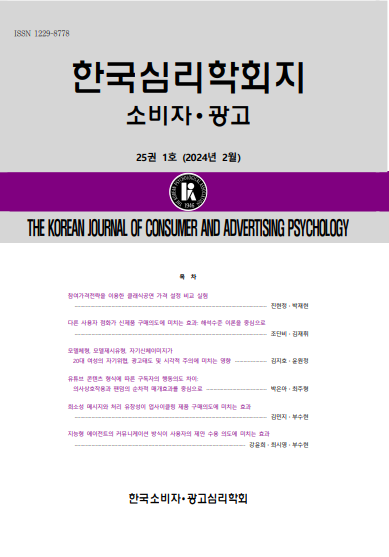open access
메뉴.png)
open access
메뉴 ISSN : 1229-8778
ISSN : 1229-8778
This research grasped their consuming behavioral pattern targeting local people in Japan with the aim of grasping the present situation and position of the Korean Wave, and looking into the future possibility of its growth and developmental direction. For the purpose of detailed analysis, first, this research understood the real condition of the general popular culture product consumption of the Japanese people, made clear the characteristics of TV dramas from various countries through image comparison of the dramas produced by Korea, Japan, and the USA, and examined Japanese people’s consciousness of international culture exchange. As a result, the Korean dramas are emerging as the second alternative followed by its products, which suggests Korean dramas are considerably generalized to the Japanese consumers. Particularly, the successful publicity of Korean dramas is not just affected by the drama “Winter Sonata”; rather, it could be interpreted as the increased number of population who are immersed in the newly released Korean dramas with interest, shedding more bright light on the possibility of growth of the Korean dramas in the future. The Korean dramas smack of strong emotional image that is differentiated from those from the USA and Japan; thus, it is analyzed that the Korean dramas can appeal to the middle-aged consumer group in Japan who originally has such a taste. In addition, it was found that the group favoring the Korean dramas is more cognizant of the common points of Korea or the Eastern culture than non-favoring group of the Korean dramas, and they show a high belief in durability of the Korean Wave. This research confirmed that the Korean Wave in Japan is not simply a boom, but it is going toward the stage of early majority or late majority beyond the level of its innovator and early adapter. Besides, it is estimated that the increase in the number of new consumers and their powerful brand loyalty will be a basis of continuous development of the Korean Wave.
김승현 (2000). “세계화와 국제커뮤니케이션연구의 새로운 문제 틀”, 언론정보학보, 14, 89-114.
서정우 대한 인식 비교”, 주관성연구, 15호, 21-40. (1997). 국제커뮤니케이션론, 서울, 나남.
윤경원․나미수 (2005). “문화지역화와 미디어 수용자 하위문화”. 한국언론학보, 49호 1권, 5-29.
윤유경․채지영 (2001). “라이브콘서트가 가수의 호감변화에 미치는 영향”. 한국심리학회지: 사회문제, 7(1), 23-36.
이선영 (2006). “글로벌 시대의 해외문화 수용: 라이선스 잡지를 중심으로”, 언론과학연구, 제6권 2호, 256-294.
이창현 (2007). “일본과 중국내 한류 수용자의 해외 문화 수용에 대한 인식 비교”, 주관성연구, 15호, 21-40.
조한혜정 (2002). “동서양 정체성의 해체와 재구성: 글로벌 지각변동의 징후로 읽는 한류 열풍”, 한국문화인류학, 제35집 1호, 3- 40.
채지영a (2003). “일본 대학생의 대중문화 상품 소비에 관한 연구”, 광고학연구, 14(3), 235-256.
채지영b (2003). “체험상품으로서의 대중음악 소비행위에 관한 연구”, 소비자학연구, 14 (2), 115-139.
채지영 (2005). “일본 한류 소비자 연구: 한류 마니아와 일반 소비자의 소비 행태를 중심으로”, 서울, 한국문화관광정책연구원.
채지영․양 윤․윤유경 (2002). “라이브콘서트 소비행위”. 한국심리학회지: 소비자 광고, 3(1), 1-15.
채지영․윤유경 (2006). “일본인의 한국 대중문화 수용실태 및 소비경험에 관한 연구”, 한국심리학회지: 소비자․광고, 7(3).
하종원․양은경 (2002). “동아시아 텔레비전의 지역화와 한류”, 방송연구, 56호, 67-104.
Gatignon, H., & Robertson, T. (1985). “A propositional inventory for new diffusion research”, Journal of Consumer Research, 11, 849-867
Helsen, K., Jedidi, K., & DeSarbo, W. S. (1993). “A new approach to country segmentation utilizing multinational diffusion patterns”, Journal of Marketing, 57, 60-71
Hirschman, E. C. & Holbrook, M. B. (1982). “Hedonic consumption: emerging concepts, methods and propositions”, Journal of Marketing Research, 46(summer), 92-101.
Holbrook, M. B. (1999). Consumer Value. New York, Routledge.
Holbrook, M. B. (1987). “What a consumer research?”, Journal of Consumer Research, 14(June), 128-132.
Holbrook, M. B., & Hirschman, E. C. (1993). The Semiotics of Consumption: Interpreting Symbolic Consumer Behavior in Popular Culture and Works of Art. Berlin: New York, Mouton de Gruyter.
Holbrook, M. B., & Hirschman, E. C. (1982). “The Experiential Aspects of Consumption: Consumer Fantasies, Feelings and Fun”, Journal of Consumer Research, 9(September), 132-140.
Holt, D. B. (1995). How consumers consume: a typology of consumption practices. Journal of Consumer Research, 22. 1-16.
Kaiser, S. (1985). The social psychology of clothing. NewYork: Macmillan College Publishing Company Inc.
McQuail, D. (2000). McQuails Mass Communication Theory, Lodon, Sage.
Rogers, E. M. (1976). New product adoption and diffusion, Journal of Consumer Research, 2, 290- 301.
Rogers, E. M. (1995). Diffusions of innovations (4th ed.) New York: The Ress Press Solomon.
Salwen, M. B. (1991). Cultural imperialism: a media effects approach, Critical Studies in Mass Communication.
Solomon, M. R. (1999). Consumer behavior: Buying, having, and being(4th ed.) Upper Saddle River, NJ: Prentice-Hall
Sreberny, A. (2000). The global and the local in international communications, Mass media and Society, pp.93-119.
石井健一 (2001). 東アジアの日本大衆文化. 東京, 蒼蒼社.
